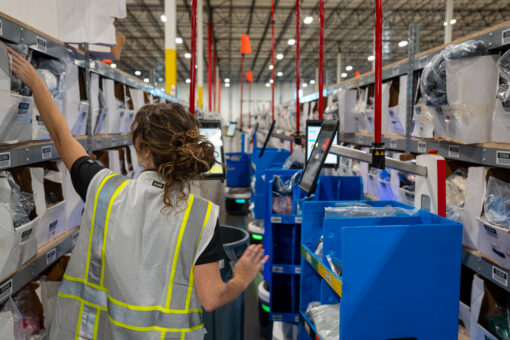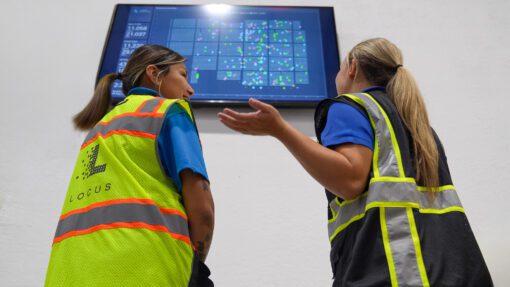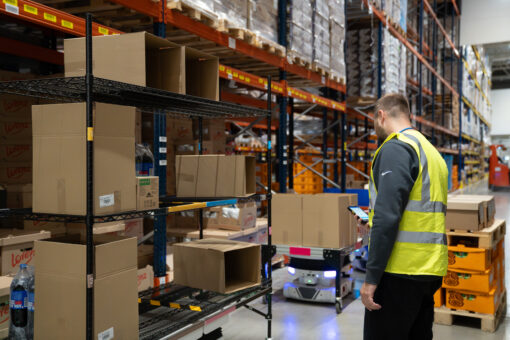WP: How to achieve 400 UPH with Locus Fast Pick
WP: How to achieve 400 UPH with Locus Fast Pick Download Now!
Improve Order Accuracy and Service Levels with Warehouse Automation
Mary Hart, Sr. Content Marketing Manager

Meeting customer expectations for timely and accurate orders is no longer just a goal but a necessity for warehouses. As e-commerce continues to grow, so does the demand for efficiency in order fulfillment. Warehouse automation is revolutionizing this space, offering solutions that significantly enhance order accuracy and service levels and help your warehouse stay ahead in a competitive market.
Warehouse automation is becoming essential for achieving high order accuracy and fast, reliable fulfillment. By reducing human error, improving inventory visibility, and accelerating picking and routing, automation helps warehouses meet industry benchmarks for accuracy and on-time delivery. With scalable robotics like autonomous mobile robots (AMRs), operations can handle peak demand, boost efficiency, and maintain superior service levels, ultimately improving customer satisfaction and operational performance.
What is Order Accuracy and Service Levels?
Order accuracy refers to the percentage of orders correctly picked, packed, and delivered without errors in your warehouse. Service levels measure your warehouse’s ability to deliver orders within the promised time frame. High performance in both areas is essential for customer satisfaction, retention, and overall operational efficiency.
Achieving high order accuracy and superior service levels is a goal for many warehouses. According to industry benchmarks from the Association for Supply Chain Management (ASCM), best-in-class warehouses aim for an order accuracy rate of 99.5-99.9% and a service level (On-Time In-Full, or OTIF) of at least 98-99%. However, inefficiencies in manual processes, human errors, and outdated systems often prevent warehouses from meeting these standards, leading to higher costs and dissatisfied customers.
3 Ways Automation Enhances Order Accuracy
Order accuracy is critical for maintaining customer satisfaction and reducing costs associated with returns and replacements. Automation provides a reliable solution to enhance accuracy in these ways:
- Reduction in Human Error: Automation significantly reduces human error. Manual picking and packing processes are prone to mistakes, but automation with solutions like AMRs ensure accurate item picking based on advanced algorithms and real-time data, leading to higher order accuracy rates and minimizing costly returns and replacements.
- Real-Time Data Integration: Automation leverages real-time data through reporting tools like LocusHub to help humans make informed decisions during the order fulfillment process. AMRs work collaboratively with human associates to ensure that each order is processed with the most current information available, which enhances overall accuracy.
- Advanced Inventory Management: Automated systems often include sophisticated inventory management solutions that provide real-time visibility into stock levels and locations, ensuring correct items are always picked.
Boosting Service Levels with Automation
Service levels are all about delivering on promises, ensuring customers receive their orders on time and in full. Automation plays a crucial role in achieving these high standards. By integrating AMRs, warehouses can streamline operations and improve service levels in several key ways:
- Faster Order Processing: AMRs significantly speed up the order fulfillment process by automating picking and transporting tasks. This increased speed ensures timely shipments, meeting or even exceeding customer expectations.
- Optimized Routing and Picking: Advanced routing algorithms enable AMRs to navigate the warehouse efficiently, reducing travel time and optimizing picking routes. This efficiency not only accelerates order processing but also reduces congestion and improves overall workflow within the warehouse.
- Scalability and Flexibility: Automation provides the scalability needed to handle peak periods without compromising service levels. During high-demand seasons, additional AMRs can be deployed to manage increased order volumes, ensuring timely fulfillment. This flexibility is crucial in maintaining high service levels regardless of fluctuating demand.
Real-World Applications
Many leading companies have successfully integrated automation to enhance their warehouse operations. For instance, the third-party logistics provider reported a 50% reduction in order processing time and a 90% improvement in order accuracy after implementing AMRs from Locus Robotics. Similarly, a leading retailer achieved a 87% increase in units per hour (UPH) picked, enabling them to meet tighter delivery windows and improve customer satisfaction.
The Future of Warehouse Automation
The trend towards automation in warehouses is set to continue, with the global warehouse automation market projected to grow significantly. According to a recent report from G2, the market is expected to reach $30 billion by 2026. As technology advances, the capabilities of AMRs will expand, offering even greater improvements in efficiency, accuracy, and service levels.
Warehouse automation, particularly through the deployment of AMRs from Locus Robotics, is transforming the logistics industry. By reducing human error, speeding up order processing, and providing scalable solutions, automation ensures that warehouses can meet the high standards of order accuracy and service levels demanded by today’s market. As warehouses continue to evolve, the integration of advanced robotics will be essential in maintaining a competitive advantage and delivering exceptional customer experiences. Embracing this technology not only improves operational efficiency but also paves the way for a more reliable and responsive supply chain.
Request a demo to see how automation strengthens your fulfillment speed and accuracy.
Frequently Asked Questions
1) What causes poor order accuracy in warehouses?
Answer: Common causes include manual picking errors, mislabeling, poor inventory visibility, and outdated fulfillment processes. Automation reduces these issues by using real-time data and precise robotic picking.
2) How does automation improve order accuracy?
Answer: Automation minimizes human error, improves inventory tracking, and ensures consistent picking paths. AMRs guide associates using optimized workflows, resulting in more accurate picks and fewer returns.
3) Can automation help improve on-time delivery performance?
Answer: Yes. Automation speeds up order processing, reduces travel time, and keeps workflows consistent. This leads to faster fulfillment and higher service levels (OTIF performance).
4) Are AMRs scalable during peak seasons?
Answer: Absolutely. AMRs can be added quickly through flexible models like Robots-as-a-Service (RaaS), allowing warehouses to handle seasonal spikes without sacrificing accuracy or speed.
5) What types of warehouses benefit most from automation?
Answer: E-commerce, retail, 3PL, and manufacturing warehouses see strong improvements in accuracy, productivity, and throughput due to the high volume and speed requirements of their operations.
6) How quickly can automation improve order accuracy and service levels?
Answer: Most warehouses experience measurable improvements, such as faster picking, fewer errors, and better workflow efficiency, within weeks of implementing AMRs.




